
Messier 9 or M9 is a globular cluster in the constellation of Ophiuchus. It is positioned in the southern part of the constellation to the southwest of Eta Ophiuchi, and lies atop a dark cloud of dust designated Barnard 64. The cluster was discovered by French astronomer Charles Messier on June 3, 1764, who described it as a "nebula without stars". In 1783, English astronomer William Herschel was able to use his reflector to resolve individual stars within the cluster. He estimated the cluster to be 7–8′ in diameter with stars densely packed near the center.

Messier 53 is a globular cluster in the Coma Berenices constellation. It was discovered by Johann Elert Bode in 1775. M53 is one of the more outlying globular clusters, being about 60,000 light-years (18.4 kpc) light-years away from the Galactic Center, and almost the same distance from the Solar System. The cluster has a core radius (rc) of 2.18 pc, a half-light radius (rh) of 5.84 pc, and a tidal radius (rtr) of 239.9 pc.

Messier 71 is a globular cluster in the small northern constellation Sagitta. It was discovered by Philippe Loys de Chéseaux in 1745 and included by Charles Messier in his catalog of non-comet-like objects in 1780. It was also noted by Koehler at Dresden around 1775.
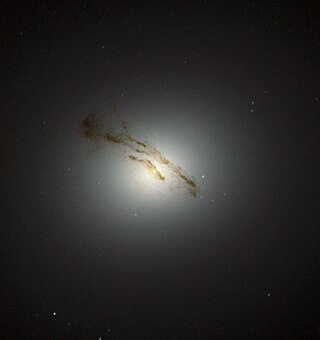
Messier 84 or M84, also known as NGC 4374, is a giant elliptical or lenticular galaxy in the constellation Virgo. Charles Messier discovered the object in 1781 in a systematic search for "nebulous objects" in the night sky. It is the 84th object in the Messier Catalogue and in the heavily populated core of the Virgo Cluster of galaxies, part of the local supercluster.
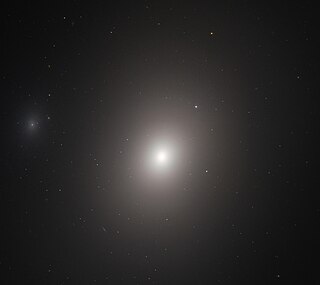
Messier 86 is an elliptical or lenticular galaxy in the constellation Virgo. It was discovered by Charles Messier in 1781. M86 lies in the heart of the Virgo Cluster of galaxies and forms a most conspicuous group with another large galaxy known as Messier 84. It displays the highest blue shift of all Messier objects, as it is, net of its other vectors of travel, approaching the Milky Way at 244 km/s. This is due to both galaxies falling roughly towards the center of the Virgo cluster from opposing ends.

Messier 90 is an intermediate spiral galaxy exhibiting a weak inner ring structure about 60 million light-years away[a] in the constellation Virgo. It was discovered by Charles Messier in 1781.

NGC 5986 is a globular cluster of stars in the southern constellation of Lupus, located at a distance of approximately 34 kilolight-years from the Sun. It was discovered by Scottish astronomer James Dunlop on May 10, 1826. John L. E. Dreyer described it as, "a remarkable object, a globular cluster, very bright, large, round, very gradually brighter middle, stars of 13th to 15th magnitude". Its prograde–retrograde orbit through the Milky Way galaxy is considered irregular and highly eccentric. It has a mean heliocentric radial velocity of +100 km/s. The galacto-centric distance is 17 kly (5.2 kpc), which puts it in the galaxy's inner halo.

NGC 1851 is a relatively massive globular cluster located in the southern constellation of Columba. Astronomer John Dreyer described it as not very bright but very large, round, well resolved, and clearly consisting of stars. It is located 39.5 kilolight-years from the Sun, and 54.1 kilolight-years from the Galactic Center. The cluster is following a highly eccentric orbit through the galaxy, with an eccentricity of about 0.7.

NGC 6229 is a globular cluster located in the constellation Hercules. It is designated as GC(v)B in the galaxy morphological classification scheme and was discovered by the British astronomer William Herschel on 12 May 1787. NGC 6229 is located at about 100,000 light years away from Earth.
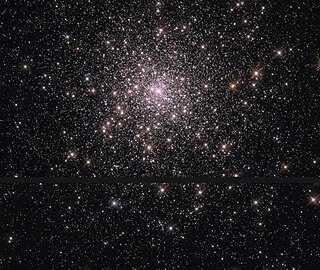
NGC 6284 is a globular cluster located in the constellation Ophiuchus. It is designated as IX in the galaxy morphological classification scheme and was discovered by the German-born British astronomer William Herschel on 22 May 1784. Its distance had previously been estimated at 49,900 light years from Earth, but this was revised in 2023 to around 43,000 light years. This same study, based on high-resolution Hubble Space Telescope optical observations, produced the first high-quality colour-magnitude diagram (CMD) of NGC 6284, extending down to about six magnitudes below its main sequence turn-off. The new observations moved its centre of gravity by 1.5–3 arcseconds from previous values, and its density profile showed a steep central cusp, suggesting that NGC 6284 is a post-core collapse (PCC) cluster.

NGC 6342 is a globular cluster located in the constellation Ophiuchus. Its Shapley–Sawyer Concentration Class is IV, and it was discovered by the German-born British astronomer William Herschel on 28 May 1786. It is at a distance of 28,000 light years away from Earth.

NGC 4473 is an elliptical galaxy located about 50 million light-years away in the constellation of Coma Berenices. It was discovered by astronomer William Herschel on April 8, 1784. NGC 4473 has an inclination of about 71°. NGC 4473 is a member of a chain of galaxies called Markarian's Chain which is part of the larger Virgo Cluster of galaxies.
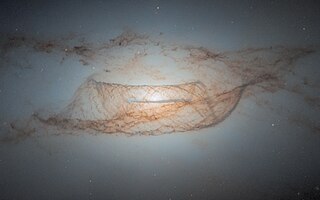
NGC 4753 is a lenticular galaxy located about 60 million light-years away in the constellation of Virgo. NGC 4753 was discovered by astronomer William Herschel on February 22, 1784. It is notable for having distinct dust lanes that surround its nucleus. It is a member of the NGC 4753 Group of galaxies, which is a member of the Virgo II Groups, a series of galaxies and galaxy clusters strung out from the southern edge of the Virgo Supercluster.

NGC 4478 is an elliptical galaxy located about 50 million light-years away in the constellation Virgo. NGC 4478 was discovered by astronomer William Herschel on April 12, 1784. NGC 4478 is a member of the Virgo Cluster.
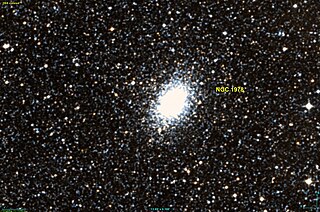
NGC 1978 is an elliptical shaped globular cluster or open cluster in the constellation Dorado. It is located within the Large Magellanic Cloud. It was discovered by James Dunlop on November 6, 1826. At an aperture of 50 arcseconds, its apparent V-band magnitude is 10.20, but at this wavelength, it has 0.16 magnitudes of interstellar extinction. It appears 3.9 arcminutes wide. NGC 1978 has a radial velocity of 293.1 ± 0.9 km/s.

NGC 4564 is an elliptical galaxy located about 57 million light-years away in the constellation Virgo. NGC 4564 was discovered by astronomer William Herschel on March 15, 1784. The galaxy is also a member of the Virgo Cluster.

NGC 4570 is an edge-on lenticular galaxy located about 57 million light-years away in the constellation Virgo. NGC 4570 was discovered by astronomer William Herschel on April 13, 1784 and is a member of the Virgo Cluster.

NGC 3311 is a super-giant elliptical galaxy located about 190 million light-years away in the constellation Hydra. The galaxy was discovered by astronomer John Herschel on March 30, 1835. NGC 3311 is the brightest member of the Hydra Cluster and forms a pair with NGC 3309 which along with NGC 3311, dominate the central region of the Hydra Cluster.
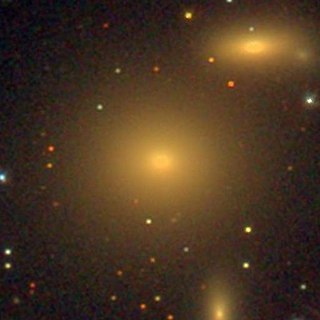
NGC 1278 is an elliptical galaxy located about 230 million light-years away in the constellation Perseus. NGC 1278 was discovered by astronomer Heinrich d'Arrest on February 14, 1863. It was then rediscovered by astronomer Guillaume Bigourdan on October 22, 1884 and was later listed as IC 1907. NGC 1278 is a member of the Perseus Cluster and is a low-luminosity AGN (LLAGN).

NGC 4365 is an elliptical galaxy located in the constellation Virgo. It was discovered by William Herschel on April 13, 1784.




















